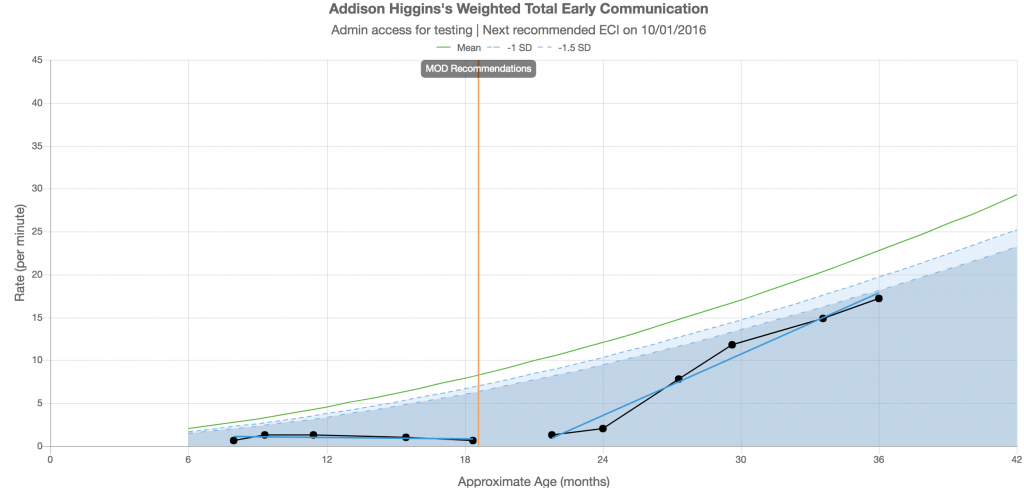Using IGDI Data to Inform Intervention Decisions
Infant and Toddler IGDI measures and the IGDI online data system provide infant-toddler service providers with the tools to individualize their services based on child outcomes. Each IGDI measure has age-based benchmarks for child performance, standard toy sets to facilitate assessments that are fun for children, forms and protocols for administration and scoring, individual child and group progress reports and graphs, and training packages to support implementation.
Features of Infant-Toddler IGDI Measures
These features of Infant-Toddler IGDI measures that make them well-suited for progress monitoring and data-driven decision making:
- They are brief – only six minutes to administer
- They can be frequently repeated to measure growth over short periods of time
- Uses for graphs of child growth in IGDI reports:
- Total scores indicate how a child is growing in a general area (e.g., expressive communication), while scores on key skill elements allow you to design intervention strategies that target deficits in specific areas (e.g., production of single words)
- They are based on a child’s observed behavior rather than parent/teacher ratings or self-reports
Our IGDI book and publications provides detailed descriptions and case studies of ways to use IGDI for decision making. Also, integrated into the IGDI Online Data System, the Making Online Decisions (MOD) application provides service providers with individualized, web-based guidance through a validated data-driven decision making model for each child that scores below benchmark on the Early Communication Indicator (ECI).
If you are not using the MOD, here is a brief overview of recommendations for using IGDIs for progress monitoring and individualizing services based on IGDI data. Also see links to additional resources at the bottom of this page.
- Conduct quarterly IGDI assessments with all children as a universal assessment to identify children with potential deficits in the area targeted by the IGDI: Communication, Cognitive Problem Solving, Movement, and/or Social Skills
- Prior to administering an IGDI assessment for a child, review his/her individual progress report and progress monitoring graph, and consider the following questions:
- Was the child’s last assessment on target, below, or slightly below benchmark?
- Is average growth (blue line) increasing or decreasing?
- How does the child’s average growth compare to expected growth (green line)?
- Is there an intervention in place (indicated by the vertical orange line)?
- For children who are below benchmark, review their key skill element graphs to determine if there are specific key skill elements that are contributing to the child’s low performance
- Administer and score the assessment
- Score the assessment live or from video
Summary
Decision-Making Steps for Children Scoring Below Benchmark
- If the assessment was valid (e.g., no concerns about how it was administered such as other children interfering with the assessment, child was sick, unresponsive play partner, etc.), enter the scores into the Online Data System
- Review the child’s progress report and graph, asking similar questions outlined above, including, How does the current score compare to prior scores? Specifically,
- Is the score closer to benchmark performance (green line) than before?
- If there were specific key skills of concern on prior assessments, have those key skills shown improvement?
- Share the results with parents and other educators or interventionists who work with the child.
- For children who score below benchmark (in the grey/blue area of the graph), we recommend
- Individualizing existing curricula, consulting with a specialist (e.g., speech language pathologist for children at risk of language delay, OT or PT for child with a motor delay), or taking other steps to address the delay as determined by your program or center.
- Administering IGDIs more frequently (e.g., monthly) in order to see more quickly how the child is responding to additional services or intervention.
- Documenting the degree with which the additional services/intervention are being implemented with the child
- Repeat Steps 2 and 3 as needed
- Consider scaffolding children’s short-term target performance based on their current score and growth trajectory.
- For example, for a child currently growing at .3 communications per month, a realistic short-term target may be .6 communications per month over the next 6 months, rather than the benchmark growth of .98. If that target is achieved, then increase the goal to .98.
The Making Online Decisions (MOD) system is designed to guide service providers through a data-driven process as described above, and provide strategic language intervention recommendations based on children’s ECI performance.
Learn about using the MOD to guide intervention decision making.

